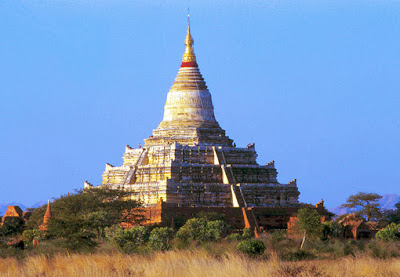Interesting sacred architectural composition and striking landmarks.
Also basic elements of the urban developments. As a main object of Buddhist worship it has spread in all countries of the world. It has developed from a hill over a grave into a religious monument.
In some of the early Buddhist art, on reliefs of the stone-fences which surrounded the Indian stupas in Bharhut (2nd century BC), Sanchi (1st to 3rd century BC) and Amaravati (1st-2nd century BC.) the image of the Stupa symbolized one of the four major events in the life of Gautama Buddha, the Parinirvana, which means that he immediately entered the Nirvana after his death.
Therefore, the image of the stupas often was taken as a symbol of the Buddha's death.
What is a stupa and definition might be useful to clarify since there are several variants. A general difference is into a temple it is possible to walk in.
The Ngakywenadaung Stupa is a 13 meter high cylindrical pagoda structure. It was covered with green-glazed tiles but now most disappeared. In Bagan are four monuments which have been covered with similar tiles. In this context it is interesting to see the different styles. Above is typical Pyu style from the 10th Century and below is the shrine in Yangon.
The most prominent sacred structure in Myanmar is probably the Shwedagon Paya in Yangon.
Shwedagon Stupa is probably together with the whole platforms where the structure stands the biggest Buddhist monument on earth since around the main "bell" are around 300 more temples and shrines of various sizes.
As such it has its basic's as a cult building, which has certain differences from the various other religious buildings in terms of shapes and materials used in construction.
A cult building.
It has undergone a complicated symbolic interpretation connected with the cosmological ideas of the peoples of the East. It is regarded as an image of the universe, as a tree or fountainhead of life symbolizing different mental states and sometimes as a symbolic representation of Buddha.
In all the way medieval people believed after the symbolism
of architectural form brings the cosmic order is expressed.
One of the main object of Buddhist veneration.
This sometimes small and often rather big buildings are widespread in the Buddhist world it is the equivalent to a church or mosque but it is not possible to walk in. It is believed to have developed from a burial mound without an interior.
From the outside it is covered with stone or brick and plastered with stucco, colored painted and sometimes gilded. Deep inside there is a small chamber for storing relics of the Buddha as souvenirs and others sacrificed to build the stupa, this are usually precious objects such as jewelry plus gold, silver etc.
Above is the Sapada Stupa or Zedi with an unique architecture it has some similarities to the Thuparama Pagoda in Sri-Lanka. As such a basic type a stupa is a characteristic Buddhist building, differences by forms and the materials used to the various other places are normal since different Buddhist countries have other interpretation of the same.
It is regarded as an image of the universe somehow like a tree or original source of life and sometimes even as a symbolic representation of Buddha. In light of the foregoing it shows the thinking pattern of the medieval man that the symbolic architectural forms should always somehow include the cosmic order.
The stupas are always the center of the architecture and fine art. The Buddha sculpture and the building itself were subject of the veneration, the numerous reliefs around decorating the wall surfaces and gatehouses were never regarded as an object of worship.
This are vivid interpretation of the life of Gautama Buddha.
The idea is from his previous incarnations of his virtues and his intellectual and moral victories. They represented a kind of introduction to Buddhism, which served the match, the construction and preparation of the uninitiated. The works of visual art also determined the relevant aspects of the reception of the ambiguous Buddhist symbolism.


















No comments:
Post a Comment